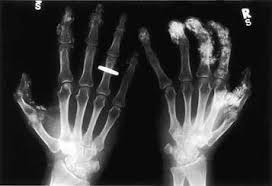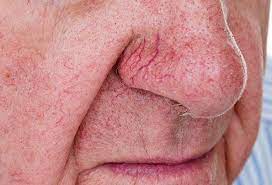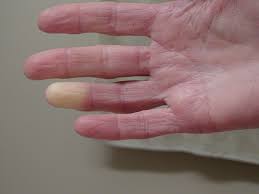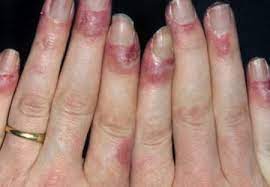


 Calcinosis cutis, Raynaud’s phenomenon, esophageal dysfunction, sclerodactyly, and telangiectasia.
Calcinosis cutis, Raynaud’s phenomenon, esophageal dysfunction, sclerodactyly, and telangiectasia.
CREST syndrome, also known as the limited cutaneous form of systemic sclerosis (lcSSc), is a multisystem connective tissue disorder.
CREST syndrome is associated with detectable antibodies against cell nucleus centromeres.
It usually spares the kidneys, which is a feature more common in the related condition systemic scleroderma.
If the lungs are involved, it is usually in the form of pulmonary arterial hypertension.
Raynaud’s phenomenon is frequently the first manifestation of CREST/lcSSc, preceding other symptoms by years.
Stress and cold temperature induce an exaggerated vasoconstriction of the small arteries, arterioles.
The thermoregulatory vessels of the skin of the digits are involved and
Raynaud’s manifests as a white-blue-red transition in skin color.
The transition to pallor and cyanosis of the digits, is followed by a reactive hyperemia as they rewarm.
This phenomenon can lead to digital ulcerations, gangrene, or amputation.
Ulceration can predispose to chronic infections of the involved site.
Esophageal dysmotility manifested by sensation of food getting stuck (dysphagia) in the mid- or lower esophagus, atypical chest pain, or cough.
Patients may drink liquids to swallow solid food.
Esophageal dysmotility problems result from atrophy of the gastrointestinal tract wall smooth muscle.
Sclerodactyly is the most easily recognizable manifestation, but it is not prominent in all patients with lcSSc.
Thickening involves the skin of the fingers distal to the metacarpophalangeal joints in CREST.
The skin may appear edematous and inflamed early on , and eventually, dermal fibroblasts overproduce extracellular matrix leading to increased tissue collagen deposition in the skin.
Collagen cross-linking causes a progressive skin tightening.
In CREST syndrome digital ischemic ulcers commonly form on the distal fingers in 30–50% of patients.
Marked telangiectasias occur on the skin of the face, the palmar surface of the hands, and the mucous membranes.
Telangiectasias tend to be more numerous in patients with other scleroderma related vascular diseases.
Telangiectasia number and the sites tend to increase over time.
Other symptoms of CREST syndrome include: fatigue, weakness, dyspnea, pain in hands and feet, dizziness and poorly healing wounds.
Patients with lcSSc commonly experience pulmonary artery hypertension which may result in cor pulmonale.
CREST syndrome involves the production of autoimmune anti-nuclear and anti-centromere antibodies.
Diagnosis
Diagnoses when a patient presents two or more of the five major clinical symptoms.
Blood exams can give a positive ANAs and anticentromere antibodies or skin biopsies can be given to help confirm a diagnosis.
Treatment:
Immunosuppressives and other medications, and esophageal reflux, pulmonary hypertension and Raynaud phenomenon may benefit from symptomatic treatment.
No cure for this disease exists.
CREST syndrome can be present in up to 10% of patients with primary biliary cholangitis.
70-90% of patients with this syndrome have anti-centromere antibodies.
Chronic edema of the hands, which leads to sclerodactyly and reabsorption of the bony tufts on distal digits.
In patients with diffuse disease visceral involvement, poor prognosis and higher mortality are present.
